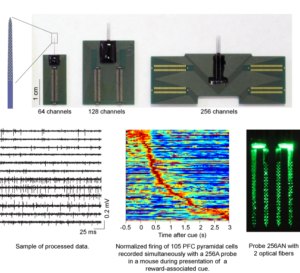We have developed silicon microprobes optimized for recording large-scale neural activity (single-unit and LFP) in awake head-immobilized mice. There are a number of design variants containing between 64 and 256 electrodes tailored for different anatomical regions. The technology can be readily integrated with optical fibers for combined optogenetic and electrophysiological experiments. Thanks to support from the NSF NeuroNex program we are pleased to offer substantial quantities of microprobes as research tools to the neuroscience community.
Procedure for acquiring microprobes:
- Click here to download information on available microprobe designs, packaging, compatible hardware options, and miscellaneous information on using the probes (e.g., electroplating, epoxy encapsulation, wirebond pad dimensions). Also download Matlab scripts that display the electrode maps referred to the 128 channel head stage from Intan Technologies. Note that if you are using probes with the connectors on the back side, you must include superscript “_bottom” to get the correct mapping. For example, to get the mapping for probe 64D type “probe_64D” if the connector is on the front, and “probe_64D_bottom” if the connector is on the back.
- Send an e-mail to Sotiris Masmanidis (smasmanidis@ucla.edu) specifying the type and number of microprobes you would like. If you are a first time user please limit initial requests to six 64 or 128 electrode microprobes. We will accommodate requests for larger quantities to experienced users as long as supplies last.
- We will forward your request to a third-party chip-on-board manufacturer who will provide you a quote for assembly and packaging. Note that the manufacturer does their best to ensure 100% yield but can neither guarantee this nor can perform testing of individual electrode functionality. We declare no financial conflict of interest in this process.
- You will receive a packaged microprobe from the manufacturer that is ready to use after a simple process involving encapsulating the wire bonds with epoxy for protection. Users are responsible for encapsulating the probes themselves, and attaching any optical fibers that may be required. We further recommend gold electroplating the electrodes for enhanced signal-to-noise ratio recordings. The 128 channel Intan head stage supports recording, electroplating, and impedance checking functions. Some sample data acquired with these tools is shown below. Microprobes can be reused dozens of times in acute experiments if appropriately cleaned after each recording session.

Please note these microprobes are not intended for clinical use.